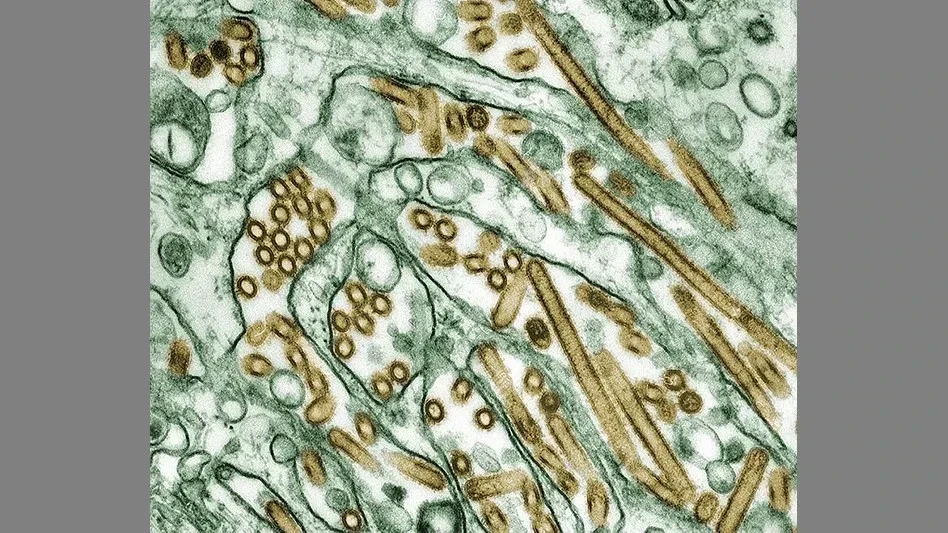More than 125 years ago, Alexander Graham Bell invented the first metal detector in an attempt to save the life of U.S. President James Garfield. The president had been shot by an assassin and doctors could not find the bullet, lodged near his spine. Unfortunately, the metal coils and framework of the bed Garfield was lying on interfered with Bell’s design. The president eventually died of infection due to non-sterile probing of his gunshot wound, but the metal detector has made great advancements since that time.
Today, metal detectors are one of the most widely used tools to control foreign matter in food processing facilities. They are such a critical aspect to food safety that they are designated as a CCP in many HACCP plans. Understanding how metal detectors work and what they can do is the key to ensuring that they are used effectively and provide consistent, reliable results.
TYPICAL SYSTEMS. Metal detectors are used in the food industry to protect equipment by preventing damage and downtime and to ensure that contaminated finished product does not reach consumers.
The most common type of metal detector used is called a “balanced coil search head,” which can detect ferrous, non-ferrous and stainless steel pieces. Another type of metal detector that is not as widely used is called a “ferrous in foil search head.” It is capable of detecting ferrous metals and magnetic steel metals.
There are four sections that make up all metal detection systems.
1. Search head — This is the piece that everyone recognizes as the metal detector. Product passes through the aperture (or opening) and is scanned for contamination.
2. User interface or control panel — Adjustments in machine sensitivity are made in this section.
3. Transport system — Used to move the product through the metal detector. This is typically a conveyor belt, or in the case of liquid- or powder-based materials, a non-metallic tube that moves the product through the aperture.
4. Reject system — There are many different styles of reject systems, including air blasts, push arms and drop chutes that are used to displace the suspect product from the line, as well as belt stop mechanisms and marking devices.
HOW DO THEY WORK? Metal detectors create a magnetic field by using a high-frequency electrical current. This is typically done with three coils. The center coil is highly energized, creating a magnetic field and the coils on each side act as receivers. When contaminated product passes through the field, it creates a disruption that triggers a change in voltage in each of the receivers. This change in voltage is processed by the machine to identify the presence of metal and trigger the reject mechanism. The sensitivity of the machine is set to detect and reject metal pieces of various sizes and/or metal composition.
VERIFICATION. Verification procedures should ensure that the metal detector search head is capable of detecting and identifying metal when challenged with a specified test piece. The procedures also should verify that the reject system is able to adequately remove suspect product from the line when identified.
During the verification exercise, allow the test piece to reject fully in order to verify that the timing is adequate and that the reject mechanism is physically able to remove or mark the product.
BEST PRACTICES. Other best practices to consider include ensuring that the rejected product is secured and controlled until it can be examined and the source of metal can be determined. This can be accomplished with locked containers, designated metal reject containers and employee training. Even the best metal detectors can be bypassed by an employee who places rejected product back on the line or turns off the metal detector or reject device when numerous rejects occur. The most important aspect of a metal detection policy is to educate employees about the significance of rejected materials and what the device is trying to tell them.
Installing an alarm or light to alert personnel about rejected product is another good idea. It is not possible to visually monitor the metal detector at all times; so an alarm or light informs the operator of rejected material. If the alarm or light fails to notify, it is an indication of equipment failure and deviation procedures should be implemented.
LIMITATIONS. A number of factors affect the metal detector’s ability to adequately identify product contaminated with metal. The performance or sensitivity of the equipment is measured and verified at the processing plant by passing a specific type of metal (usually a ferrous, non-ferrous or stainless steel test piece) through the aperture to verify sensitivity and functionality. Factors that affect sensitivity include the type, shape and orientation of the metal, aperture size, position of the metal in the product, environmental conditions, speed of inspection and product characteristics.
The area at any side of the metal detector that is closest to the wall of the aperture is the most sensitive. The area directly in the middle of the aperture is the least sensitive and poses the greatest challenge in detecting and rejecting the test piece. Spherical test pieces are most commonly used as they provide a consistent shape, or orientation, no matter how or where they are passed through the metal detector. The smaller the aperture, the more sensitive the metal detector will be.
How easily a type of metal is detected depends on magnetic permeability, which means how easily the metal is magnetized coupled with the electrical conductivity of the metal. Material that is easily magnetized and more conductive is easier to detect. The hardest metal type to detect is stainless steel, which is usually non-magnetic and a poor conductor of electricity. The size, length, shape and type of the metal impacts how easily it is detected.
Environmental factors also impact metal detection. Fluorescent lights, radios, walkie-talkies, inverter drives or other devices that are in close proximity to metal conveyors interfere with the operation of the machine and can trigger false rejects. Large sources of nearby metal, such as other equipment, also can impact the sensitivity and reliability of the machine.
The conditions under which the detector operates are another large factor. Temperature and vibration reduce the sensitivity of the machine. Positioning a metal detector near an oven or blast tunnel will create thermal shock. Wet cleaning can damage the electrical components or create thermal shock if hot water is used.
Food products also affect metal detection sensitivity. Wet or conductive products such as meat, cheese, warm bread, pickles, and jams and jellies cause what is called a “product effect signal” within the metal detector. These products can conduct electricity and cause a signal in the metal detector even when they are completely free of metal. For these types of materials, the metal detector has to be set to reduce or eliminate the product signal to prevent false rejects.
The speed of inspection is not a commonly identified limitation. Conveying systems don’t typically reach speeds that will negatively impact the sensitivity of the metal detector. But, performance limits may be an issue where they are used to inspect product that is pneumatically conveyed through a tube for detection.
The age of the metal detector and its electronic components is another factor that effects sensitivity. Aging of electronic components and temperature variations cause instability.
CHALLENGE FREQUENCY. When and how often the metal detector should be challenged depends on the risk that the facility is willing to accept. At a minimum, most facilities check the metal detector at the beginning and end of production and after any breaks where the line and the metal detector are down. This ensures that product has been placed through a functioning metal detector during the entire period of the shift and verifies that the metal detector is functional after the line has stopped. Many facilities check them on a predetermined frequency, such as hourly, so that the amount of product that needs to be held and retested in a functioning metal detector in the case of a failure is more limited.
Metal detectors and reject mechanisms also should be verified at product changeover. This is especially important when the product change could affect the sensitivity settings or when a change in product size could affect the timing of the reject mechanism. If either of these is non-functional, then the metal detector is rendered ineffective to identify and remove contaminated material.
CONCLUSION. Metal detectors are a common and highly effective tool used to identify and eliminate foreign material in our food products. When employee training, proper equipment installation and operation, and understanding of the system’s capabilities are in place, the metal detection system becomes an effective tool in ensuring the safety of our food products.
The author is Director of Product Development, AIB International.
Latest from Quality Assurance & Food Safety
- IFT Virtual Workshop on Food Fraud Prevention to Address Supply Chain Disruptions
- Penn State Course Covers Fundamentals of Food Science
- Joint FAO/WHO Expert Committee on Food Additives Seeks Experts
- FDA Reschedules Webinar on Updated ‘Healthy’ Claim
- Thousands More Laid Off at FDA, CDC in HHS Restructuring
- USDA Extends Deadline on Request for Information for Poultry Quality Standards
- Dessert Holdings Issues Allergy Alert on Undeclared Pecans in Favorite Day Cheesecake
- Idaho Smokehouse Partners Recalls Beef Sticks Due to Possible Foreign Matter Contamination





